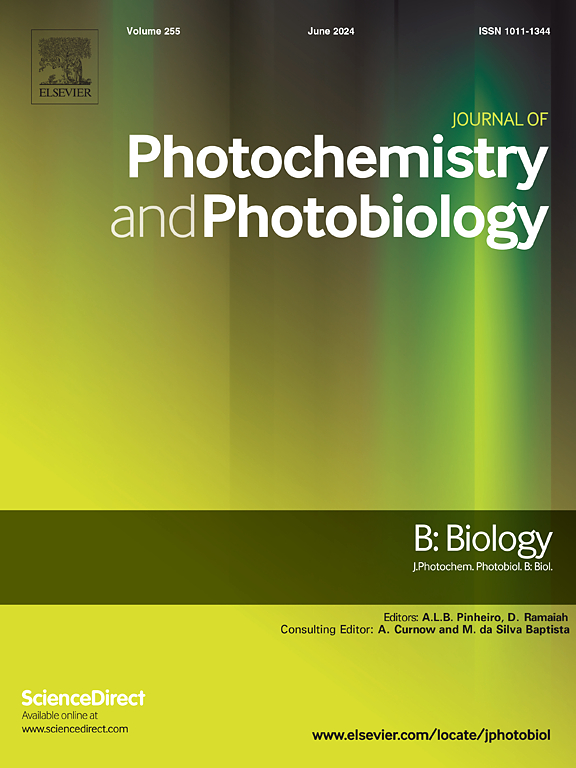ct-DNA compaction by nanoparticles formed by silica and gemini surfactants having hydroxyl group substituted spacers: In vitro, in vivo, and ex vivo gene uptake to cancer cells
IF 3.9
2区 生物学
Q2 BIOCHEMISTRY & MOLECULAR BIOLOGY
Journal of photochemistry and photobiology. B, Biology
Pub Date : 2024-11-13
DOI:10.1016/j.jphotobiol.2024.113066
引用次数: 0
Abstract
Hybrid nanoparticles formed by Silica (SiO2) coated with cationic gemini surfactants with variable hydroxyl group substituted spacers, 12-4(OH)-12,2Br− and 12-4(OH)2-12,2Br− have shown a great extent of compaction of calf thymus DNA (ct-DNA) compared to conventional counterpart cationic surfactant, dodecyl trimethylammonium bromide (DTAB). Study shows not only the hydrophobicity of the spacer but also the hydrogen bonding interactions between the hydroxyl group substituted spacer and DNA have a great role in DNA compaction. 12-4(OH)2-12,2Br− is more efficient in compacting ct-DNA compared to 12-4(OH)-12,2Br− due to the stronger binding of the former with ct-DNA than the latter. While 12-4(OH)-12,2Br− makes 50 % ct-DNA compaction at its 0.63 μM concentration in the presence of SiO2 nanoparticles, the same % of compaction can be achieved at a concentration as low as 0.25 μM of 12-4(OH)2-12,2Br−. However, DTAB makes 50 % ct-DNA compaction at a concentration as high as 7.00 μM under the same condition. Therefore, the present systems address the very common challenge, i.e., cytotoxicity due to cationic surfactants. The system of 12-4(OH)2-12,2Br− coated SiO2 nanoparticles displays the maximum cell viability (≥90 %), causing the least cell death in the mouse fibroblast cells (NIH3T3) cell lines compared to the cell viability of ≤80 % for DTAB. 12-4(OH)2-12,2Br− coated SiO2 nanoparticles system has presented excellent in vitro cellular uptake of genes on mouse mammary gland adenocarcinoma (4T1) cells after incubating for 3 h and 6 h. In vivo study shows that 12-4(OH)2-12,2Br− coated SiO2 nanoparticles system takes the highest amount of ct-DNA in cells and tumors in a time-dependent manner. The ex vivo studies using different organs of the mice demonstrate that the tumor sites in the breast of the mice are most affected by these formulations. Cytotoxicity assays and cellular uptake studies suggest that the present systems can be used for potential applications for gene delivery and oncological therapies.

由二氧化硅和具有羟基取代间隔物的双子表面活性剂形成的纳米颗粒对 ct-DNA 的压实作用:癌细胞的体外、体内和体外基因吸收
与传统的阳离子表面活性剂十二烷基三甲基溴化铵(DTAB)相比,由二氧化硅(SiO2)包覆阳离子双子表面活性剂(12-4(OH)-12,2Br- 和 12-4(OH)2-12,2Br-)形成的混合纳米粒子在很大程度上压实了小牛胸腺 DNA(ct-DNA)。研究表明,不仅是间隔物的疏水性,羟基取代的间隔物与 DNA 之间的氢键相互作用也在 DNA 压实过程中发挥了重要作用。与 12-4(OH)-12,2Br- 相比,12-4(OH)-12,2Br- 能更有效地压实ct-DNA,这是因为前者与ct-DNA 的结合力比后者强。在二氧化硅纳米颗粒存在的情况下,浓度为 0.63 μM 的 12-4(OH)-12,2Br-能使 50% 的ct-DNA 压缩,而浓度低至 0.25 μM 的 12-4(OH)2-12,2Br-也能达到相同的压缩率。然而,在相同条件下,DTAB 的浓度高达 7.00 μM 时,ct-DNA 的压实率为 50%。因此,本系统解决了一个非常普遍的难题,即阳离子表面活性剂引起的细胞毒性。12-4(OH)2-12,2Br- 包覆二氧化硅纳米粒子的体系显示出最高的细胞存活率(≥90%),与 DTAB 的≤80%的细胞存活率相比,该体系在小鼠成纤维细胞(NIH3T3)细胞系中造成的细胞死亡最少。体内研究表明,12-4(OH)2-12,2Br-包覆的二氧化硅纳米粒子系统以时间依赖性的方式在细胞和肿瘤中摄取了最大量的ct-DNA。利用小鼠不同器官进行的体内外研究表明,这些制剂对小鼠乳房肿瘤部位的影响最大。细胞毒性测定和细胞吸收研究表明,本制剂可用于基因递送和肿瘤治疗。
本文章由计算机程序翻译,如有差异,请以英文原文为准。
求助全文
约1分钟内获得全文
求助全文
来源期刊
CiteScore
12.10
自引率
1.90%
发文量
161
审稿时长
37 days
期刊介绍:
The Journal of Photochemistry and Photobiology B: Biology provides a forum for the publication of papers relating to the various aspects of photobiology, as well as a means for communication in this multidisciplinary field.
The scope includes:
- Bioluminescence
- Chronobiology
- DNA repair
- Environmental photobiology
- Nanotechnology in photobiology
- Photocarcinogenesis
- Photochemistry of biomolecules
- Photodynamic therapy
- Photomedicine
- Photomorphogenesis
- Photomovement
- Photoreception
- Photosensitization
- Photosynthesis
- Phototechnology
- Spectroscopy of biological systems
- UV and visible radiation effects and vision.

 求助内容:
求助内容: 应助结果提醒方式:
应助结果提醒方式:


